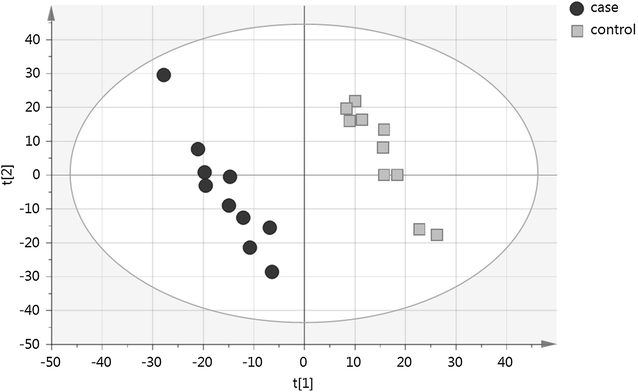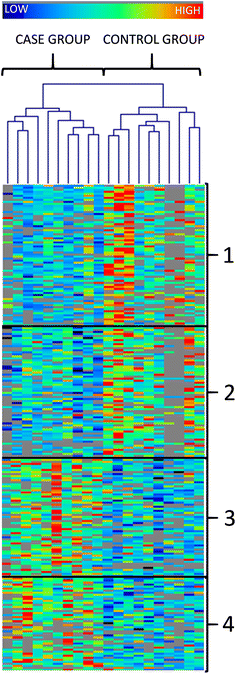Non-targeted metabolite profiling reveals changes in oxidative stress, tryptophan and lipid metabolisms in fearful dogs
- PMID: 26867941
- PMCID: PMC4751666
- DOI: 10.1186/s12993-016-0091-2
Non-targeted metabolite profiling reveals changes in oxidative stress, tryptophan and lipid metabolisms in fearful dogs
Abstract
Background: Anxieties, such as shyness, noise phobia and separation anxiety, are common but poorly understood behavioural problems in domestic dogs, Canis familiaris. Although studies have demonstrated genetic and environmental contributions to anxiety pathogenesis, better understanding of the molecular underpinnings is needed to improve diagnostics, management and treatment plans. As a part of our ongoing canine anxiety genetics efforts, this study aimed to pilot a metabolomics approach in fearful and non-fearful dogs to identify candidate biomarkers for more objective phenotyping purposes and to refer to potential underlying biological problem.
Methods: We collected whole blood samples from 10 fearful and 10 non-fearful Great Danes and performed a liquid chromatography combined with mass spectrometry (LC-MS)-based non-targeted metabolite profiling.
Results: Non-targeted metabolomics analysis detected six 932 metabolite entities in four analytical modes [RP and HILIC; ESI(-) and ESI(+)], of which 239 differed statistically between the test groups. We identified changes in 13 metabolites (fold change ranging from 1.28 to 2.85) between fearful and non-fearful dogs, including hypoxanthine, indoxylsulfate and several phospholipids. These molecules are involved in oxidative stress, tryptophan and lipid metabolisms.
Conclusions: We identified significant alterations in the metabolism of fearful dogs, and some of these changes appear relevant to anxiety also in other species. This pilot study demonstrates the feasibility of the non-targeted metabolomics and warrants a larger replication study to confirm the role of the identified biomarkers and pathways in canine anxiety.
Figures


Similar articles
-
A non-targeted metabolite profiling pilot study suggests that tryptophan and lipid metabolisms are linked with ADHD-like behaviours in dogs.Behav Brain Funct. 2016 Sep 29;12(1):27. doi: 10.1186/s12993-016-0112-1. Behav Brain Funct. 2016. PMID: 27686065 Free PMC article.
-
Fearful dogs have increased plasma glutamine and γ-glutamyl glutamine.Sci Rep. 2018 Oct 29;8(1):15976. doi: 10.1038/s41598-018-34321-x. Sci Rep. 2018. PMID: 30374076 Free PMC article.
-
Early Life Experiences and Exercise Associate with Canine Anxieties.PLoS One. 2015 Nov 3;10(11):e0141907. doi: 10.1371/journal.pone.0141907. eCollection 2015. PLoS One. 2015. PMID: 26528555 Free PMC article.
-
Canine anxieties and phobias: an update on separation anxiety and noise aversions.Vet Clin North Am Small Anim Pract. 2008 Sep;38(5):1081-106, vii. doi: 10.1016/j.cvsm.2008.04.012. Vet Clin North Am Small Anim Pract. 2008. PMID: 18672155 Review.
-
Separation, Confinement, or Noises: What Is Scaring That Dog?Vet Clin North Am Small Anim Pract. 2018 May;48(3):367-386. doi: 10.1016/j.cvsm.2017.12.005. Epub 2018 Feb 1. Vet Clin North Am Small Anim Pract. 2018. PMID: 29397241 Review.
Cited by
-
Active and social life is associated with lower non-social fearfulness in pet dogs.Sci Rep. 2020 Aug 13;10(1):13774. doi: 10.1038/s41598-020-70722-7. Sci Rep. 2020. PMID: 32792641 Free PMC article.
-
A non-targeted metabolite profiling pilot study suggests that tryptophan and lipid metabolisms are linked with ADHD-like behaviours in dogs.Behav Brain Funct. 2016 Sep 29;12(1):27. doi: 10.1186/s12993-016-0112-1. Behav Brain Funct. 2016. PMID: 27686065 Free PMC article.
-
Genome-wide association studies of 74 plasma metabolites of German shepherd dogs reveal two metabolites associated with genes encoding their enzymes.Metabolomics. 2019 Sep 6;15(9):123. doi: 10.1007/s11306-019-1586-2. Metabolomics. 2019. PMID: 31493001
-
Anxiety disturbs the blood plasma metabolome in acute coronary syndrome patients.Sci Rep. 2021 Jun 18;11(1):12897. doi: 10.1038/s41598-021-92421-7. Sci Rep. 2021. PMID: 34145340 Free PMC article.
-
Metabolomics in the study of spontaneous animal diseases.J Vet Diagn Invest. 2020 Sep;32(5):635-647. doi: 10.1177/1040638720948505. Epub 2020 Aug 18. J Vet Diagn Invest. 2020. PMID: 32807042 Free PMC article. Review.
References
-
- Tiira K, Lohi H. Reliability and validity of a questionnaire survey in canine anxiety research. Appl Anim Behav Sci. 2014;155:82–92. doi: 10.1016/j.applanim.2014.03.007. - DOI
Publication types
MeSH terms
Substances
LinkOut - more resources
Full Text Sources
Other Literature Sources
Medical
Research Materials

